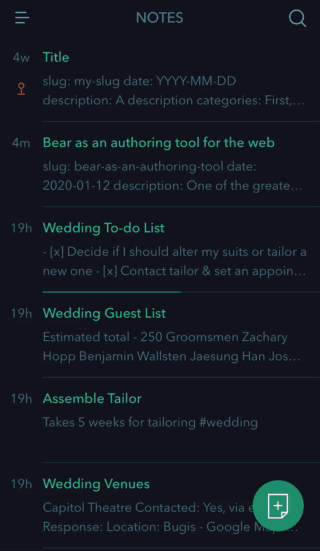Bear as an authoring tool for the web
This is note 2 of 5 in a series on publishing automation.

Above - Publishing from Bear to this website. Dreams do come true ❤️
Bear is hands down my favorite note taking app. Its apps are iOS native (not Electron or React Native apps slinging JavaScript), and as a result achieve a level of feel-good performance on par with Apple’s first party apps. Even more importantly, it uses the user’s own iCloud storage as a backend so Shiny Frog, the people that build Bear, never see any user data — period. Sure it’s an Apple-only product, but in a world awash with bad hybrid apps and malicious practices around user data, Bear is simple, beautiful and safe.
To boot, I and a lot of other people are most productive when writing in Bear. So naturally, wouldn’t it be great if we could use Bear to publish to other platforms, like the website you’re reading right now? I think yes, but there are obstacles:
There are no external publishing APIs
Bear ships on iOS, macOS and watchOS — not on Android or Windows, but a web app is forthcoming. The team is very clear about their priorities, and adding integrations to Bear isn’t one of them. However, this focus is clearly why Bear is so great. Thus, there’s no officially supported way to use Bear as an authoring tool for other platforms. Unless of course you count WordPress for iOS, which recently added functionality to publish from Bear and only works if you’re using WordPress to start with. More info on that here.
It’s really hard to integrate apps on Apple platforms
App sandboxing adds a level of safety to the Apple ecosystem, but it also makes it much more difficult for apps to integrate with one another. That means if Bear doesn’t ship with functionality to publish to another platform, good luck trying to pull that off. It does however support the x-callback-url protocol and clearly documents the interfaces, but while this is very nice compared to other native iOS/macOS apps, it’s still much less accessible than having an actual REST API to call.
A solution
Until Shiny Frog ships a way to build off of Bear as an authoring tool, the best way to make it a reality to is build this pipeline yourself. In the next few articles I’ll talk in greater depth about how I did just that:
- JavaScript in iOS with Scriptable
- AWS Lambda functions via Netlify
- Programmatic publishing to Contentful
Previous articles in this series:
Thanks for reading! Go home for more notes.